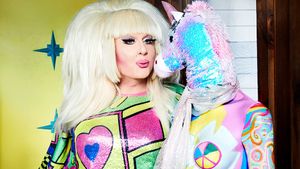By 1920, the U.S.. Navy and prison system adopted denim uniforms. But it wasn't until famous 1930s big-screen cowboys, like John Wayne and James Stewart, shot some charisma into waist overalls in Westerns, that denim saw its first truly national audience. Vacationing Easterners would return home with denim souvenirs, then only sold out West - even if they went unworn. No man of class would be caught dead wearing denim outside the house.
WWII may have caused production to lag, but that didn't stop denim from assuming the role of Statesman during the war effort. European soldiers fell in love with denim they saw for the first time on their American counterparts and traded nearly anything they could to get their hands on a pair - an irony that perhaps caused more than a few Genovese Navy men to stir in their graves.
But jeans graduated from fashion history footnote to true fashion icon with the rebellious youth of the 1950s. Unruly teenagers and their onscreen avatars, like James Dean in Rebel Without a Cause and Marlon Brando in The Wild One, wore denim jeans as a sign of defiance. Defiant teens and newly minted rock stars of the day ate them up, christening them their own by calling them "blue jeans" despite back-pocket flashers that still called them waist overalls. Anti-denim dress codes in hotels, restaurants, and even stores made jeans anti-authoritarian just by default. (Bing Crosby was even once famously denied a hotel room for wearing denim.) By the end of the '50s, blue jeans were sold coast to coast, and by 1961, after Marilyn Monroe went head-to-toe denim in The Misfits, even girls were getting in on the fun.
A funny thing happened to denim as the 1960s got trippy. Rather than fade out of style, a new generation fell in love. Kids in the free-loving '60s embraced denim as a pallet for individuality. Styles loosened up and embroidery, paint, patchwork or any kind of hand-made psychedelic design cemented denim's new legacy as the contemporary garment of rebellion. Meanwhile, as the first denim stores opened in Europe during the '60s, American blue jeans were slowly being smuggled into Communist bloc countries, inspiring a different kind of anti-authoritarian sentiment.
Who could have imagined that a fabric favored for centuries by laborers would one day come to go hand in hand with liberty, freedom, and, as the 20th century went on, high fashion?






































































